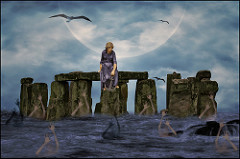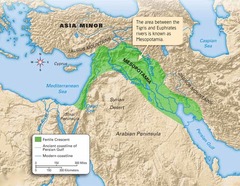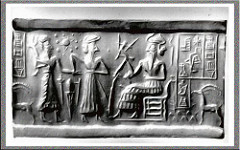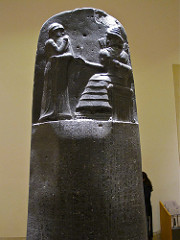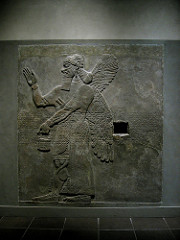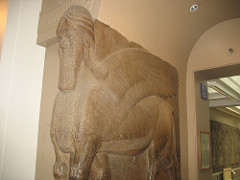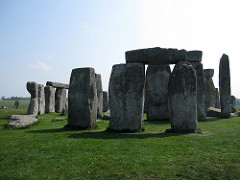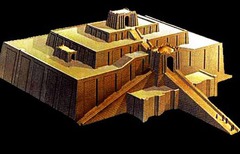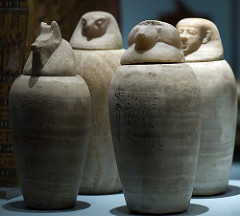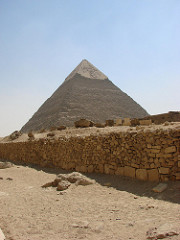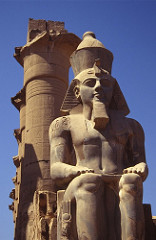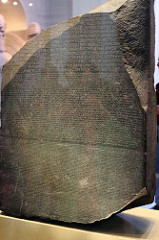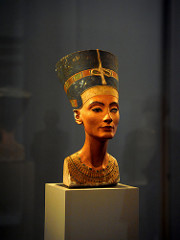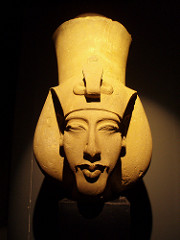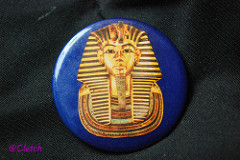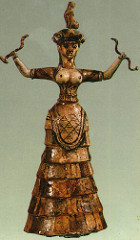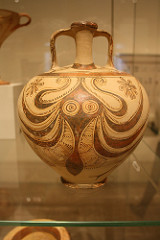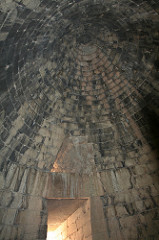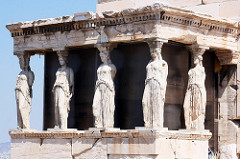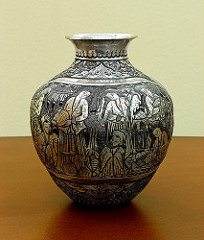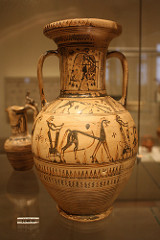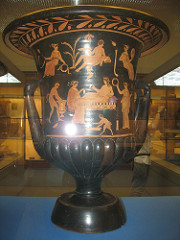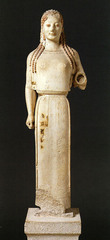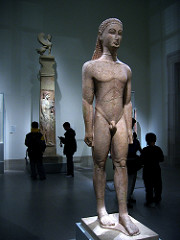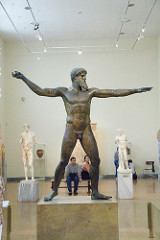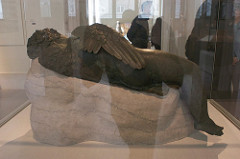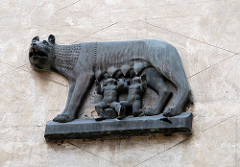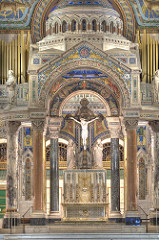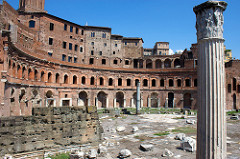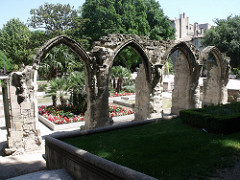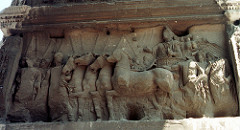Venus of Laussel
Limestone relief sculpture; traces of red ochre pigment; woman is holding an animal horn
Chinese Horse lascaux
painting of horse on limestone rock; sagging body may suggest pregnancy; arrows or plants near it; small head
bull lascaux
Paleo, 15,000 BCE
capstone
a stone that forms the top of wall or building
megalith
memorial consisting of a very large stone forming part of a prehistoric structure (especially in western Europe)
dolmen
a prehistoric megalith typically having two upright stones and a capstone
Stonehedge
2500-1500 BCE Neolithic. Salisbury Plain, Wiltshire, England. Could have been built around the same time as pyramids. Famous because of its many myths and legends and is best preserved.Diameter of circle is 97 ft. long.
mesopotamia
the land between the Tigris and Euphrates
cylinder seal cuneiform
a cylindrical piece of stone usually about an inch or so in height, decorated with an incised design, so that a raised pattern was left when the seal was rolled over soft clay. In the ancient Near East, documents, storage jars, and other important possessions were signed, sealed, and identified in this way
lyre sound box bull's head
comes from the tomb of Queen Puabi around 2685 BC. its made up of wood and inlaid gold lapis lazuli and shell its 13 in high. the images on the from represent mythological creatures.
Babylonian Code of Law
hammurabi
stele
an ancient upright stone slab bearing markings
King Assyria
one of many kings who ruled mesopotamia after the fall of Sumer
Lamassu
Assyrian guardian in the form of a man-headed winged bull
cromlech
a prehistoric megalith typically having two upright stones and a capstone
ziggurat
a rectangular tiered temple or terraced mound erected by the ancient Assyrians and Babylonians
Palette of King Narmer
Egypt
Green schist (slate)
3000-2600 B.C.E.
mastaba
an ancient Egyptian mudbrick tomb with a rectangular base and sloping sides and flat roof
canopic jar
a jar used in ancient egypt to contain entrails of an embalmed body
pyramids of giza
was built on west side of Nile, closer to the Sun God. Khafre - son of Khufu, and Menkaure - grandson of Khufu. behind are three smaller pyramids for his wives.
sphinx
one of a number of large stone statues with the body of a lion and the head of a man that were built by the ancient Egyptians
funerary temple of Queen Hapshetsut
...
Temple of Ramses II
1290-1224 BCE; New Kingdom; Abu Simbel, Egypt; Sandstone
rosetta stone
an inscription of a black basalt stone
Queen Nefertiti
1345 BCE.
Painted limestone.
akhenaten
early ruler of Egypt who rejected the old gods and replaced them with sun worship (died in 1358 BC)
King Tut
Known as the boy king because he ruled for 9 years and died before his 20th birthday
Aegean
an arm of the Mediterranean between Greece and Turkey
cycladic idol
idols found in Ancient Aegea; no facial features except nose; long necks; folded arms no negative space; very similar forms
minoan
a Cretan who lived in the bronze-age culture of Crete about 3000-1100 BC
thesus and minotaur
A boy went over to slay the beast and then he told his father that if the beast was dead that he would make the sail white. He forgot and his father jumped off a cliff and died and they called it the Aegian sea.
snake goddess
from the palace at Knossos, Crete, Minoan, ca. 1600 BCE, Faience. This figurine may represent a priestess, but more likely a bare-breasted goddess. The snakes and feline imply that she has power over the animal world.
octopus vase
Palaikastro, Crete. ca. 1500 BCE stirrup jar
parthenon
the main temple of the goddess Athena
corbeling
layers of flat stones without mortar to form walls with each layer further inward that the previous
tholos tomb
In Mycenean architecture, a beehive-shaped tomb with a circular plan.
caryatid porch
ladies holding up building extension
geometric vase
used for mixing wine, male vessel (WOMEN DIDNT DRINK) this specific piece is a gravemarker. Geometric period-designs, fear of open space. can tell mourners are women, boobs come out of armmpits, male has small penis. procession below
black figure vase
A vase which depicted the main focus of the art on it as black (geometric period)
red figure vase
later Greek pottery, silhouetting of red figures against black background; painted linear details!
peplos kore
530 BCE, Archaic Period. female counterpart to Kouros. patterned treatment of hair, archaic smile, arms attached to side. women are never portrayed nude.
New York Kouros
600 BC (Archaic)
-Left Leg in front (BATTLE STANCE)
-YOUNG MALE
-PERFECTION OF HUMAN FORM
-FISTS CONNECTED TO THIGHS
Contrappasto
refers to natural weight shift; natural curve in a body- slightly turned head perhaps and not gazing into endlessness
poseidon
(Greek mythology) the god of the sea and earthquakes in ancient mythology
nike
(Greek mythology) winged goddess of victory
Athena
(Greek mythology) goddess of wisdom and useful arts and prudent warfare
doric order
the oldest and simplest of the Greek orders and the only one that normally has no base
Sleeping Eros
3rd century b.c.-early 1st century a.d.
Greek or Roman
Bronze
hellenistic
capitoline wolf
Bronze portrayal of a she-wolf. used as the symbol of Rome. Children later addition. Shows great sense of animal anatomy.
coliseum
an oval large stadium with tiers of seats
Basilica
an early Christian church designed like a Roman basilica
nave
the central area of a church
trajan market
best example of groin vault with windows
allowing maximum of interior space with least amount of walls
pont du guard
Brought water from a distant mountain spring to Nimes(France). About 100 gallons a day for each inhabitant. 16 BCE
pantheon
(antiquity) a temple to all the gods
arch of titus
dedicated to emperor titus
built by domitian
built in 81-82 AD
in the roman forum
made of travertine
carving inside it shows the sacking of jerusalem
single arch

